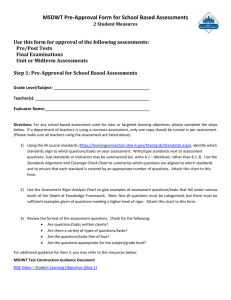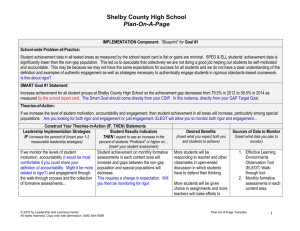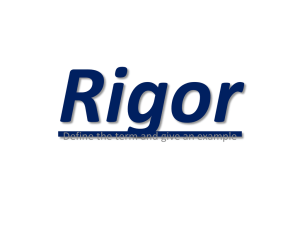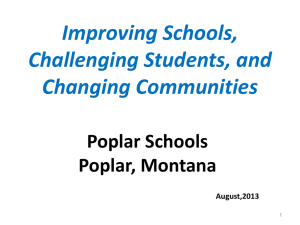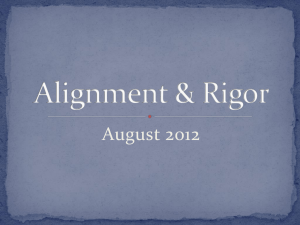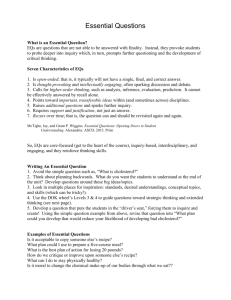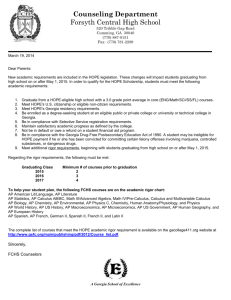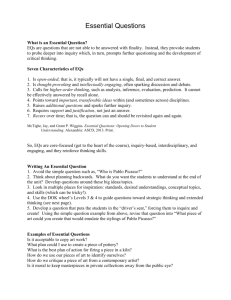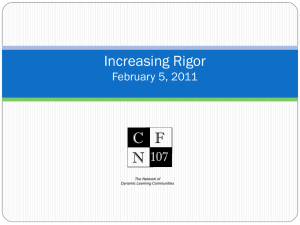Worksheet
advertisement
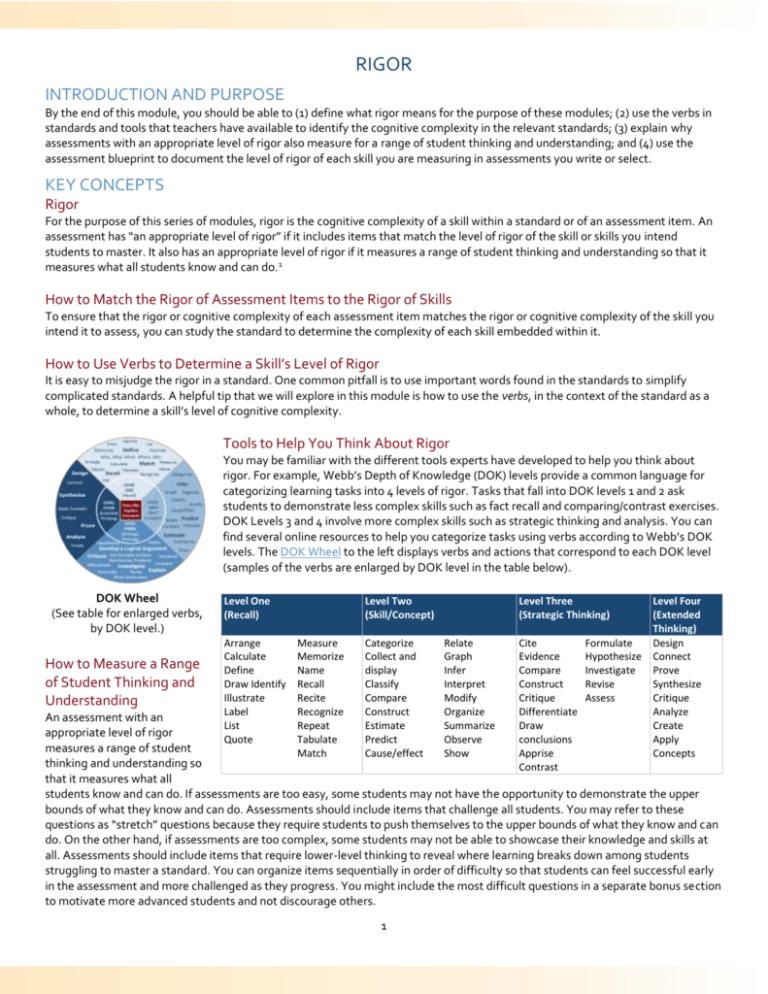
RIGOR INTRODUCTION AND PURPOSE By the end of this module, you should be able to (1) define what rigor means for the purpose of these modules; (2) use the verbs in standards and tools that teachers have available to identify the cognitive complexity in the relevant standards; (3) explain why assessments with an appropriate level of rigor also measure for a range of student thinking and understanding; and (4) use the assessment blueprint to document the level of rigor of each skill you are measuring in assessments you write or select. KEY CONCEPTS Rigor For the purpose of this series of modules, rigor is the cognitive complexity of a skill within a standard or of an assessment item. An assessment has “an appropriate level of rigor” if it includes items that match the level of rigor of the skill or skills you intend students to master. It also has an appropriate level of rigor if it measures a range of student thinking and understanding so that it measures what all students know and can do. 1 How to Match the Rigor of Assessment Items to the Rigor of Skills To ensure that the rigor or cognitive complexity of each assessment item matches the rigor or cognitive complexity of the skill you intend it to assess, you can study the standard to determine the complexity of each skill embedded within it. How to Use Verbs to Determine a Skill’s Level of Rigor It is easy to misjudge the rigor in a standard. One common pitfall is to use important words found in the standards to simplify complicated standards. A helpful tip that we will explore in this module is how to use the verbs, in the context of the standard as a whole, to determine a skill’s level of cognitive complexity. Tools to Help You Think About Rigor You may be familiar with the different tools experts have developed to help you think about rigor. For example, Webb’s Depth of Knowledge (DOK) levels provide a common language for categorizing learning tasks into 4 levels of rigor. Tasks that fall into DOK levels 1 and 2 ask students to demonstrate less complex skills such as fact recall and comparing/contrast exercises. DOK Levels 3 and 4 involve more complex skills such as strategic thinking and analysis. You can find several online resources to help you categorize tasks using verbs according to Webb’s DOK levels. The DOK Wheel to the left displays verbs and actions that correspond to each DOK level (samples of the verbs are enlarged by DOK level in the table below). DOK Wheel (See table for enlarged verbs, by DOK level.) How to Measure a Range of Student Thinking and Understanding Level One (Recall) Arrange Calculate Define Draw Identify Illustrate Label List Quote Level Two (Skill/Concept) Measure Memorize Name Recall Recite Recognize Repeat Tabulate Match Categorize Collect and display Classify Compare Construct Estimate Predict Cause/effect Level Three (Strategic Thinking) Relate Graph Infer Interpret Modify Organize Summarize Observe Show Cite Evidence Compare Construct Critique Differentiate Draw conclusions Apprise Contrast Formulate Hypothesize Investigate Revise Assess Level Four (Extended Thinking) Design Connect Prove Synthesize Critique Analyze Create Apply Concepts An assessment with an appropriate level of rigor measures a range of student thinking and understanding so that it measures what all students know and can do. If assessments are too easy, some students may not have the opportunity to demonstrate the upper bounds of what they know and can do. Assessments should include items that challenge all students. You may refer to these questions as “stretch” questions because they require students to push themselves to the upper bounds of what they know and can do. On the other hand, if assessments are too complex, some students may not be able to showcase their knowledge and skills at all. Assessments should include items that require lower-level thinking to reveal where learning breaks down among students struggling to master a standard. You can organize items sequentially in order of difficulty so that students can feel successful early in the assessment and more challenged as they progress. You might include the most difficult questions in a separate bonus section to motivate more advanced students and not discourage others. 1 CHECK FOR UNDERSTANDING Assessment Items 1. Using Webb’s Depth of Knowledge levels, identify the level or levels of rigor in this standard from Iowa. Remember to pay close attention to the verbs. Understand the use of geographic tools to locate and analyze information about people, places, and environments. 2 2. Explain in your own words why well-designed assessments should measure a range of student thinking and understanding. Answers 1. Using Webb’s Depth of Knowledge levels, identify the level or levels of rigor in this standard from Iowa. Remember to pay close attention to the verbs. Understand the use of geographic tools to locate and analyze information about people, places, and environments. 3 The key verbs in the skills in this standard are “use” and “analyze,” which are associated with lower- and higher-order skills. “Understand” is a level 2 skill, and “analyze” is a level 4 skill. 2. Explain in your own words why well-designed assessments should measure a range of student thinking and understanding. Well-designed assessments include items with various levels of rigor to ensure that they measure what all students know and can do. If assessments are too easy, some students may not have the opportunity to demonstrate the upper bounds of what they know and can do. I should include items in my assessment that challenge all of my students. On the other hand, if assessments are too complex, some students may not be able to showcase their knowledge and skills at all. I can include items that require lower-level thinking to reveal where learning breaks down among students struggling to master a standard. 11 Kansas State Department of Education, “Assessment Literacy Project”; Ohio Department of Education, “Assessment Literacy: Identifying and Developing Valid and Reliable Assessments” (2013); Relay Graduate School of Education, Designing and Evaluating Assessments (2014); and Rhode Island Department of Education, “Deepening Assessment Literacy.” 2 Iowa Department of Education, “Iowa Core K-12 Social Studies” (2010). 3 Ibid. 2
